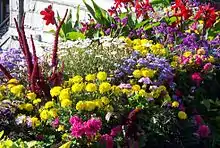Pollinator garden
A pollinator garden is planted and designed, with specific nectar and pollen producing plants, in a way that attracts pollinating insects known as pollinators.[1] In order for a garden to be considered a pollinator garden, it should provide (but not limited to) the following: various nectar producing flowers, shelter or shelter providing plants for pollinators, avoid the use of pesticides, and place similar flowers close to one another.[2]


.jpg.webp)
Overview
In 2015 the National Pollinator Garden Network launched its Million Pollinator Garden Challenge which encourages the entire nation to become aware of pollinators and their role.[3] This challenge hopes to raise awareness so that existing habitats may be preserved and new habitats may be created. This project aims to help people understand the important role that pollinators play and why it is important to protect them. If pollinator habitats are not protected and new habitats are not created the lack of pollination to plants will ultimately affect humans. The main source of human nutrition, crops (e.g. vegetables and fruits) without pollination will suffer.[4][5] It's not just the crops that are in danger, 80-95% of plant species other than crops require some form of pollination.[6] Pollinator gardens are a way for these habitats to remain protected and encourage pollinators to continue pollinating plants around the world.
Politics
Pollinator gardens are now making their way into politics. In 2015 the American Society of Landscape Architects (ASLA) joined forces with New York Senator Kirsten Gillibrand to encourage pollinator habitats on transportation right-of-way. This bill will be close to that of the bill H.R. 2738, the Highways Bettering the Economy and Environment Pollinator Protection Act[7]
In June 2017 The House of Representatives moved the bill H.R. 3040. In Section 1. of the bill says that the Act may be referred to as "Saving America's Pollinators Act of 2017" This bill calls upon the Environmental Protection Agency (EPA) to take actions against particular pesticides that may negatively impact pollinators.[8]
Examples
- Dolores Pollinator Boulevard San Francisco, California
- A pollinator strip lies within the Regenstein Fruit & Vegetable Garden at the Chicago Botanic Garden in Chicago, Illinois
- Pollinators in Parks in 2017 Park Pride teamed up with Atlanta Botanical Garden to increase pollinator friendly plantings in five of Atlanta's parks.
- Pollinator Pathways This method can be seen in several cities.
- Wildlife Sanctuary located at Seattle University in Seattle, Washington
See also
References
- Shepherd, M., & Vaughn, M. (2011). Attracting Native Pollinators: Protecting North America’s Bees and Butterflies : the Xerces Society Guide. Storey Publishing.
- Society, T. X. (2016). Gardening for Butterflies: How You Can Attract and Protect Beautiful, Beneficial Insects. Portland, Oregon: Timber Press.
- "Official site". Million Pollinator Garden Challenge. Retrieved 8 January 2018.
- Klein, A-M, et al. "The importance of pollinators in changing landscapes for world crops". Proceedings of the Royal Society B 274 (1608): 303-313.
- Eilers, E.J. et al. "Contribution of Pollinator-Mediated Crops to Nutrients in the Human Food Supply" PLoS One 6(6): e21363. doi:10.1371/journal.pone.0021363
- Vaudo, A. D, Tooker, J.F., Grozinger, C.M. and H.M. Patch. "Bee nutrition and floral resource restoration." Current Opinion in Insect Science 10:133-141 (2015).
- Hastings, A. (2015, June 12). Text - H.R.2738 - 114th Congress (2015-2016): Highways Bettering the Economy and Environment Pollinator Protection Act [webpage]. Retrieved December 6, 2017, from https://www.congress.gov/bill/114th-congress/house-bill/2738/text
- Conyers, J. (2017, July 11). Text - H.R.3040 - 115th Congress (2017-2018): Saving America’s Pollinators Act of 2017 [webpage]. Retrieved December 6, 2017, from https://www.congress.gov/bill/115th-congress/house-bill/3040/text